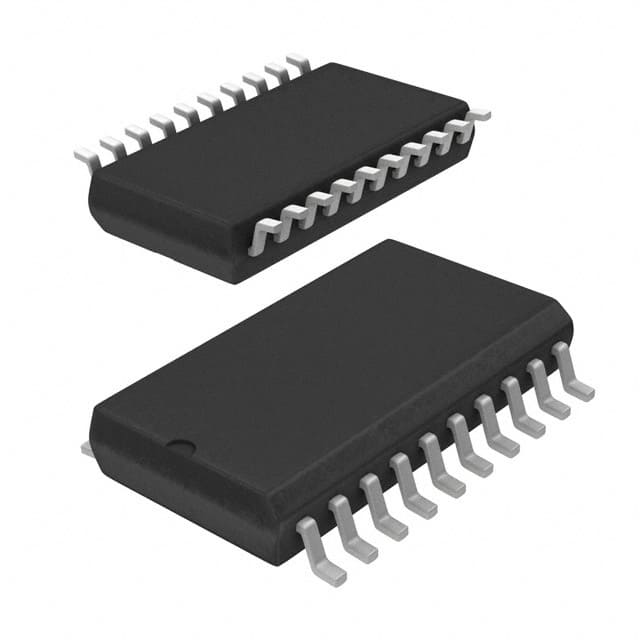Encyclopedia Entry: 74F541SJ
Product Overview
Category
The 74F541SJ belongs to the category of integrated circuits (ICs) and specifically falls under the family of octal buffers/drivers with 3-state outputs.
Use
This product is commonly used in digital electronic systems for signal buffering and driving applications. It provides a convenient way to control the flow of data between different components within a circuit.
Characteristics
- Octal buffer/driver IC
- 3-state outputs
- High-speed operation
- Low power consumption
- Wide operating voltage range
- Robust design for reliable performance
Package
The 74F541SJ is typically available in a 20-pin small outline integrated circuit (SOIC) package. This package offers compactness and ease of integration into various electronic systems.
Essence
The essence of the 74F541SJ lies in its ability to efficiently buffer and drive signals, ensuring reliable data transmission between different parts of a digital circuit.
Packaging/Quantity
The 74F541SJ is commonly sold in reels or tubes containing multiple units. The exact quantity may vary depending on the supplier and customer requirements.
Specifications
- Supply Voltage: 4.5V to 5.5V
- Input Voltage: 0V to Vcc
- Output Voltage: 0V to Vcc
- Operating Temperature Range: -40°C to +85°C
- Maximum Propagation Delay: 10ns
- Maximum Output Current: ±15mA
Detailed Pin Configuration
The 74F541SJ has a total of 20 pins, each serving a specific purpose. Here is a detailed pin configuration:
- OE (Output Enable)
- A1 (Input A1)
- Y1 (Output Y1)
- A2 (Input A2)
- Y2 (Output Y2)
- A3 (Input A3)
- Y3 (Output Y3)
- GND (Ground)
- Y4 (Output Y4)
- A4 (Input A4)
- Y5 (Output Y5)
- A5 (Input A5)
- Y6 (Output Y6)
- A6 (Input A6)
- Y7 (Output Y7)
- A7 (Input A7)
- Vcc (Supply Voltage)
- Y8 (Output Y8)
- A8 (Input A8)
- OE (Output Enable)
Functional Features
- Octal buffer/driver with 3-state outputs
- High-speed operation for efficient data transmission
- Output enable (OE) pin allows control over the output state
- Wide operating voltage range enables compatibility with various systems
- Robust design ensures reliable performance in different environments
Advantages and Disadvantages
Advantages
- Fast propagation delay for quick signal processing
- Low power consumption for energy-efficient operation
- Versatile application possibilities due to wide operating voltage range
- Compact package size facilitates integration into electronic systems
Disadvantages
- Limited output current capacity may restrict use in certain high-power applications
- Lack of built-in protection features against electrical faults or ESD events
Working Principles
The 74F541SJ operates by receiving input signals on its eight input pins (A1-A8). These signals are then buffered and amplified before being transmitted to the corresponding output pins (Y1-Y8). The output enable (OE) pin controls the state of the outputs, allowing them to be either active or in a high-impedance state.
Detailed Application Field Plans
The 74F541SJ finds extensive use in various digital electronic systems, including but not limited to:
- Microprocessors and microcontrollers
- Memory systems (RAM, ROM)
- Data communication devices
- Industrial automation equipment
- Automotive electronics
- Consumer electronics
Detailed and Complete Alternative Models
There are several alternative models available that offer similar functionality to the 74F541SJ. Some notable alternatives include:
- SN74LS541: Octal buffer/driver with 3-state outputs from Texas Instruments.
- MC74HC541A: Octal buffer/driver with 3-state outputs from ON Semiconductor.
- CD74HCT541: High-speed CMOS octal buffer/driver with 3-state outputs from Texas Instruments.
These alternative models can be considered based on specific application requirements and availability.
In conclusion, the 74F541SJ is a versatile octal buffer/driver IC used in digital electronic systems for signal buffering and driving applications. Its high-speed operation, low power consumption, and wide operating voltage range make it suitable for various industries. While it has advantages such as fast propagation delay and compact package size, limitations include limited output current capacity and lack of built-in protection features.
Lista 10 Vanliga frågor och svar relaterade till tillämpningen av 74F541SJ i tekniska lösningar
Sure! Here are 10 common questions and answers related to the application of 74F541SJ in technical solutions:
Q: What is the 74F541SJ? A: The 74F541SJ is a octal buffer/line driver with 3-state outputs, commonly used in digital logic circuits.
Q: What is the maximum operating voltage for the 74F541SJ? A: The maximum operating voltage for the 74F541SJ is typically 5.5V.
Q: How many input/output pins does the 74F541SJ have? A: The 74F541SJ has 8 input pins and 8 output pins.
Q: Can the 74F541SJ be used as a level shifter? A: Yes, the 74F541SJ can be used as a level shifter to convert signals between different voltage levels.
Q: What is the purpose of the 3-state outputs in the 74F541SJ? A: The 3-state outputs allow multiple devices to share a common bus without interfering with each other.
Q: What is the maximum output current that the 74F541SJ can drive? A: The 74F541SJ can typically drive up to 15mA of output current per channel.
Q: Can the 74F541SJ be used in high-speed applications? A: Yes, the 74F541SJ is designed for high-speed operation and can be used in applications with fast switching requirements.
Q: Does the 74F541SJ require external pull-up or pull-down resistors? A: No, the 74F541SJ has internal pull-up resistors on its inputs, eliminating the need for external resistors in most cases.
Q: Can the 74F541SJ be used in both TTL and CMOS logic systems? A: Yes, the 74F541SJ is compatible with both TTL and CMOS logic levels.
Q: What is the typical power consumption of the 74F541SJ? A: The typical power consumption of the 74F541SJ is relatively low, making it suitable for battery-powered applications.
Please note that the answers provided here are general and may vary depending on specific datasheet specifications and application requirements.


